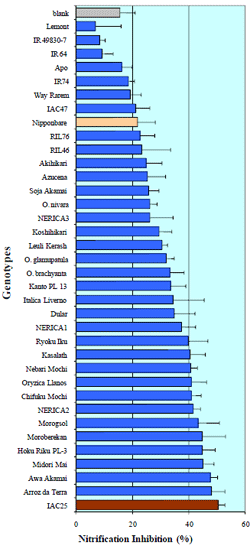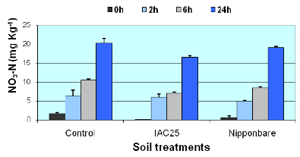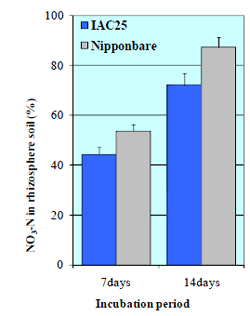Nitrification inhibition activity, a novel trait in root exudates of rice
Description
Nitrification, in which ammonia (NH3) is converted to nitrate (NO3-), is an important process in soil-plant systems for providing plant-available nitrate (NO3-). However, when nitrification occurs rapidly, NO3- supply may exceed plant demand; thus NO3-, which is less stable in soils compared to ammonium (NH4+) is easily lost through leaching, run off or denitrification. Recent research suggest that root exudates from Brachiaria humidicola can inhibit nitrification in soil, which opens possibilities for using biological nitrification inhibition (BNI) as a low-cost in situ biological alternative. We have tested whether BNI activity is present in the root exudates of rice (Oryza sativa L.), tested the extent of its variation among different genotypes, and its potential effect on nitrification inhibition in soil.
In an initial screening experiment, the BNI activity in the root exudates of 36 different rice genotypes (cultivated, traditional and wild relatives) was evaluated for two consecutive years using a bioassay based on a recombinant Nitrosomonas strain. This strain carries a luciferase gene (luxAB) that produces bioluminescence under normal growing conditions; reduced bioluminescence indicates decrease of reducing power in the cell due to the inactivation of ammonia monooxygenase (an effect of known nitrification inhibitors). Significant genotypic variation was detected with the upland cultivar IAC25 demonstrating consistently high BNI activity, whilst modern lowland varieties like Nipponbare or IR64 exhibited lower activity (Fig.1).
A confirmation whether the activity of root exudates remains functional in soil then followed. The effect of a single application of concentrated root exudates was tested on BNI using standard soil incubation and shaken slurry method. For the standard method, soil was amended with root exudates, (NH4)2SO4 and water in order to reach 60% of the water-holding capacity and incubated at 30°C. For the slurry method, soil was added with root exudates, NH4+ and PO43-, and shaken constantly to maintain aerobic condition. Aliquots were taken at different points of time. NH4+ and NO3- were determined using a continuous flow auto-analyzer. Soil incubated with added exudates from IAC25 had lower NO3- concentrations after 7 days of incubation compared to soil incubated with water. In addition, soil amended with the root exudates of IAC25 had lower NO3- concentrations using the slurry method, confirming the potential of IAC25 for BNI (Fig.2).
Subsequently, rhizosphere soil containing deposited exudates from the rice roots was obtained by stripping off the soil from the roots of 50 day-old rice plants grown in small pots. This rhizosphere soil was incubated using the standard incubation method for different periods of time. After 7 days of incubation, a small but significant reduction in NO3- formation was seen in IAC25 relative to a low NI-genotype Nipponbare, and this difference increased after 14 days (Fig.3). Therefore, the potential of IAC25 was once again confirmed by detecting lower NO3- levels in incubation experiments.
Our results provide the first evidence that the root exudates of rice can reduce nitrification rates in soil. Having proven this for rice, a model crop, offers possibilities for further exploitation of this phenomenon through molecular and genetic tools.
Figure, table
-
Fig. 1.
Percentage of nitrification inhibition in the root exudates of rice genotypes. Data correspond to the average of three independent replicates for two consecutives years. Four readings were taken for each replicate. -
Fig. 2.
Nitrate accumulation in soil incubated with the root exudates of two rice genotypes for several hours. Soil was incubated following the standard soil incubation and shaken slurry method. Control refers to soil incubated without exudates. -
Fig. 3.
Percent of total N in nitrate form in the rhizosphere soil of two rice genotypes after incubation for 7 and 14 days. The initial nitrate in the untreated soil was 20%.
- Affiliation
-
Japan International Research Center for Agricultural Sciences Crop Production and Environment Division
- Classification
-
Administration B
- Term of research
-
FY2006~2010
- Responsible researcher
-
PARIASCA-TANAKA Juan ( Crop Production and Environment Division )
WISSUWA Matthias ( Crop Production and Environment Division )
ISHIKAWA Takayuki ( Crop Production and Environment Division )
- ほか
- Publication, etc.
-
https://doi.org/10.1093/aobpla/plq014
Pariasca Tanaka J, Nardi P, Wissuwa M. (2010) Nitrification inhibition activity, a novel trait in root exudates of rice. AoB PLANTS 2010: plq014
- Japanese PDF



